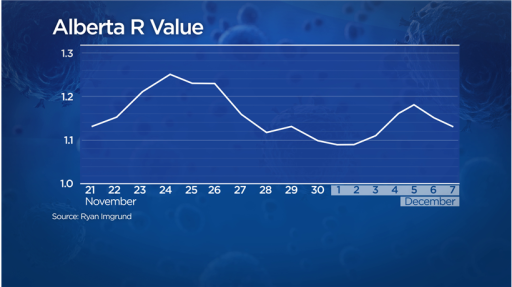Criticism is being directed at the Alberta government over how the provincial reproductive number, also known as R value, is not being shared with the public amid the COVID-19 pandemic.
Late November, Premier Jason Kenney said the R value would be used to determine if restrictions are lifted on Dec. 15. At the time, he said he would like to see the R value below one, ideally at 0.8.
Read more:
Alberta may receive early COVID-19 vaccines as province confirms additional 1,735 cases
While Alberta Health had previously been providing Global News with the R value when asked, it stopped doing so after Nov. 24, when new restrictions were announced.
“We’ll be discussing that at our next meeting of the cabinet COVID committee about what metrics to release and when to release them,” Kenney said on Dec. 2 when Global News asked why the R value was not being publicly released.

The R value describes how the virus spreads within a population; a R value of one means one person would transmit the virus to one other person and so on while a R value of two means one person transmits the virus to two people and so on and so forth.
Epidemiologists, infectious disease specialists and other experts say a R value of below one is needed to get the pandemic under control.
“I think there’s really been an erosion of public trust in the government and the government’s response to the pandemic. We’ve seen leaked tapes. We’ve seen a reluctance to release modelling. We’ve seen some concern around maybe the government wasn’t transparent about planning for field hospitals,” Lorian Hardcastle, a professor in the Faculty of Law and Cumming School of Medicine at the University of Calgary said.
Read more:
First coronavirus vaccine shots could be doled out in Canada next week
“When you have all of these concerns around transparency, this really just adds to that. It’s another thing that I think the public wonders, ‘Why aren’t they sharing this information and is there some reasons for it?’”
Hardcastle said when trust is low, more information is better to ensure Albertans not only trust the government but comply with provincial restrictions.
“If decisions are being made around this value, the public should have access to that information, researchers should have access to that information, clinicians should have access to that information,” she said.

Last Friday, chief medical officer of health Dr. Deena Hinshaw was asked what that day’s R value was.
She responded that she did not have the current value at that time but said that the R value is still over one because case numbers are rising.
Biostatistician Ryan Imgrund, who works with Ottawa Public Health on that city’s R value, said his research shows that, as of Dec. 7, Alberta’s R value is at 1.13.

Biostatistician Ryan Imgrund, who calculates R values for Ottawa Public Health, has been calculating Alberta’s R value.
Global News
“It’s a value people should know. The reproductive value is a value which is not just making decisions, but it’s intrinsic to the disease as well,” he said, adding it is “problematic” to not have access to that data.
“If you have this value, you can really see the trend of your cases. It’s very, very easy to just see case counts go down one or two days and think things are okay. But if your case counts go down one or two days but your reproductive value is still higher than one, it means it’s only a temporary thing.”
Imgrund said it is important for people to see the R value so they can make their own choices; Hardcastle agrees, saying that the R value can send a powerful message about how your actions can have direct consequences on others.

“A value of 1.1 means the number of daily cases in the next month will actually double. If the value is 1.3, it means the number of daily cases would go up by a factor of 10 in the next month. It’s really important… any small change in that reproduction value has a significant impact on the daily case numbers,” Imgrund said.
For Imgrund, Alberta’s situation is very concerning because, not only is the reproductive value high, the province’s case numbers are also high.
“It means whatever you’re doing now is not enough to take the case numbers down, it’s not even enough to plateau.”
Imgrund projects that Alberta is on track to see 2,500 cases by the weekend and around 4,000 cases by Christmas.
Read more:
‘Full of sadness’: Alberta doctor shares heartbreaking details on working the COVID-19 ward
Developmental biologist Gosia Gasperowicz said the R value tells the story of how the province is doing and whether spread is slowing and whether measures are working.
But she said reaching a particular goal, such as an R value of one, does not necessarily mean restrictions should be lifted.
“If we have the R below one, we have to keep it below one. We cannot stop doing what we are doing,” she said.